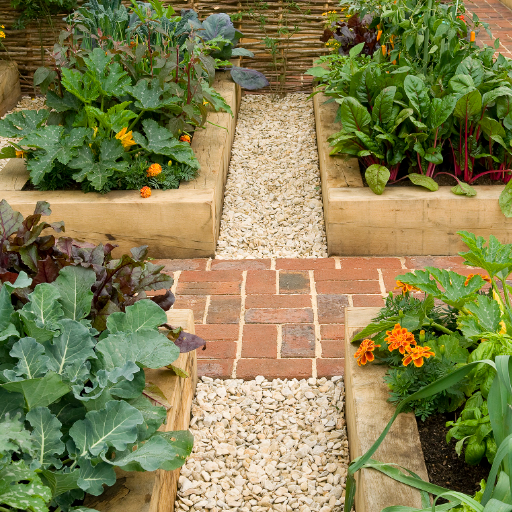Starting a small vegetable garden can be really exciting and rewarding since beginner gardeners would want to grow their own food. Whether limited to a patch of backyard, or a balcony, or simply the making of a great vegetable garden is definitely possible with the right set of instructions. This blog will share tips and ideas to maximize your space and select vegetables for your garden. This guide will assist you in everything pertaining to landscaping to basic maintenance while inspiring the complete novice with confidence to embark on this exciting journey. Prepare to start digging and enjoy that first-ever gratification derived from self-grown vegetables!
Getting Started with Your Small Vegetable Garden

It is important to pick an appropriate place for your garden, preferably a place where the sun shines directly for a minimum of 6-8 hours a day. For those who are short on outdoor space, alternatives like balcony containers, vertical gardens, or raised beds provide a great solution. Whatever the choice, always make sure proper drainage exists in the site so the water does not remain there and that water access is available for irrigation. Choosing a location itself gives an edge to planting, enabling the vegetables with the best conditions to grow.
Choosing the Right Location for Your Garden
In the first phase of garden plot selection, I prefer sites receiving some six to eight hours, at least, of direct sunlight for healthy plant growth. The fact that outdoor space can sometimes be very limited makes me brainstorm space-maximizing alternatives such as balcony containers, vertical gardening setups, or maybe even raised bed-building. Drainage must be ensured wherever you have set the garden site to keep those puddles away. Plus, the water supply must be easily reachable for irrigation. Making sure these considerations are in place allows the perfect setting for my vegetables to grow.
Essential Tools for the New Gardener
A handful of tools lie at the heart of efficient and enjoyable gardening. I always have a solid trowel and a pair of good pruning shears to initiate the work of planting and trimming. A good garden fork would be useful to aerate the soil and break any compacted dirt layers. For bigger digging jobs, I must have a heavy-duty spade and a reliable rake to level the soil. Some quality garden gloves are always a good investment: They protect my hands from thorns and mildew. It’s essential to have a watering can or a hose with an adjustable nozzle as they will keep plants consistently hydrated. A kneeling pad and a wheelbarrow will do much to prevent strain and ease material transport. With the above-mentioned tools at hand, I feel ready to attend to any general gardening task and further the healthy growth of my plants.
Planning Your First Vegetable Garden Layout
I learned that the essential steps in planning for the layout of the first vegetable garden involve assessing available space and sunlight. I consider any place with direct sunlight of at least six to eight hours because most vegetables need that much sun to grow. After that comes the size of the garden, with a decision of how many rows or beds we can fit and still take care of comfortably. The good sharing point is that he considered only veggies that his family likes to eat-such as tomatoes, cucumbers, and carrots-as well as those suited to the climate and the growing season. I then consider companion planting to maximize space and deter pests by grouping compatible plants together but not allowing tall plants to overshadow the smaller ones. In short, this ensures a productive, easy-to-maintain garden layout.
Vegetables to Grow in a Small Space

Vegetables that produce abundantly and provide compact growth and flexibility would best suit cultivation in a smaller area. Spinach and lettuce are leafy greens that grow fast, and any part can be harvested several times, so they make for greater productivity. Root veggies like carrots and radishes are best suited in a small, deep container and require a minuscule amount of space. Climbing plants such as pole beans and peas take advantage of vertical space when placed on trellises. Herbs such as basil, cilantro, and parsley can fit into any small patch of garden space and continuously help improve your food preparation. When you choose crops to suit your family’s tastes and either go with vertical gardening or container gardening, you will see a productive and efficient small-scale garden.
Top Vegetables for Beginner Gardeners
Initially, I advise novice gardeners to plant forgiving, easy-to-grow vegetables. Leafy greens like lettuce and spinach are ideal because they mature fast and require little maintenance. Root vegetables such as carrots and radishes are equally suitable for beginners: they grow best in loose, well-drained soil and require very little care. Tomatoes, on the other hand, are suitable for containers and smaller gardens and give a rewarding harvest when properly watered and sunlit. Zucchini for farmers looking for versatility grows fast and produces abundantly, while herbs such as basil and mint can fit into small spaces and take one’s cuisine up a notch. These vegetables give plenty of satisfaction to cultivate, and being successful will build your gardening confidence.
Seasonal Vegetables to Consider
It is best to take into account the climate of the region and the present season in deciding on seasonal vegetables to grow. For example, spring vegetables like lettuce, spinach, and radishes enjoy the cool weather, and because they mature quickly, they provide an early harvest. Summer would be ideal for the planting of warm-season vegetables such as tomatoes, cucumbers, peppers, and zucchini that relish all the sunlight. This time of the year-the fall-offers the last set of planting options, with hardy vegetables such as kale, broccoli, and carrots that can take the chill. Winter could also be productive in the mild climates or if protected by cold frames; Swiss chard, leeks, and winter spinach are the vegetables to consider. Placing your vegetables according to the growing season will give you the maximum yield and help you garden successfully throughout the year.
Growing Vertically: Maximizing Space
Growing vertically is an excellent way to maximize limited garden space while enhancing productivity. I employ all sorts of structures like trellises, arbors, and vertical planters to grow climbing plants such as beans, peas, and cucumbers. Hanging baskets also lend themselves well to smaller plants, like strawberries and herbs. Wall-mounted planters or even repurposed shelves get mounted onto walls to develop more planting areas without consuming ground space. In this fashion, I employ every bit of space available and keep the garden neat and functional.
Garden Design Ideas for Small Spaces

Since every small-space garden must put functionality first while capitalizing on the area available, from using containers of various sizes that help group plants into an easy-to-handle and pleasing arrangement, everything can be in one’s control. A vertical gardening option should go high up, be it a trellis, hanging baskets, or wall-mounted planters, in order to maximize the use of space and lend some depth to the design. Plant selection is very important-think miniature or dwarf varieties and mixes edible with ornamental plants to create a garden with two purposes. Use mirrors, light-colored elements, or reflective surfaces meanwhile to enlarge the pick-me-up feel of the space.
Raised Bed Gardening for Efficient Use of Space
Raised beds enable one to maximize available space, simultaneously promoting organization and plant health. Using raised beds lets me control the soil quality better so that my plants are nurtured to their fullest potential with the nutrients required for their growth. The container also inhibits weed growth and ensures a neat and practical planting layout. I also value the fact that raised beds provide better drainage, an important factor in avoiding waterlogged roots. Properly planned, it becomes possible to plant those with similar growing needs so that they bloom well, thereby giving me value for the space.
Container Gardening: Versatile Options
Amongst questionable claims made by product sellers, usually exaggerated, one of the most astounding yet occasionally true is that container gardening arguably offers tremendous potential to those with limited space or special growing requirements. I find it useful in my garden because it allows me to either go with or against numerous containers—terracotta, plastic, ceramic, or whatever can be recycled for the purpose—according to my plants and aesthetics. Lightweight pots make it easy to move plants around to either get more sunlight on them or protect them from unfavorable weather. Another advantage is in controlling the soil composition and pH levels inside each container to fit particular plants’ needs. On the other hand, the use of containers will almost limit the possibility of pest or disease transmission, thus making it very practical and efficient to raise vegetables, herbs, or decorative plants almost anywhere.
Companion Planting for a Thriving Garden
Companion planting is something that has really changed the game in my garden; therefore, I let mother nature work towards giving plants health and full productivity. I try to pair plants that complement each other in reducing pest pressure or in enhancing nutrient availability. For example, I will plant marigolds alongside tomatoes to deter harmful insect pests or basil to improve growth and flavor. Beans grow alongside corn, enriching the soil with nitrogen while the corn stalks provide support for the climbing beans. This way, the use of space is maximized, creating a healthy ecosystem requiring fewer chemicals and interventions.
Starting Your Seeds and Care Techniques

Getting the seeds started begins with selection of the containers and soil. Seed trays or little pots with proper drainage should be filled to the brim with nutrient-bearing but fast-draining seed-starting mix. Sow seeds to the recommended depth for the plant type, cover lightly with soil, and water gently-soil should be kept just moist. Locate containers in a warm spot sufficiently lit with light, either on a sunny windowsill or under grow lights, so that the seeds may germinate well. After seedlings have emerged, be sure to monitor moisture levels, ensure adequate ventilation to avoid fungal growth, and then, if possible, raise them in the outdoors by means of “Hardening-Off” prior to transplanting in the garden.
How to Start Seeds Indoors
Starting seeds indoors is a rewarding endeavor that allows me to get a jump on the gardening season. I choose a seed-starting medium that, on the one side, retains moisture and, on the other hand, offers good drainage, and fill my containers with it after they have been cleaned out. Next, I place seeds at the recommended depth and spacing with a fine layer of loose medium on top-nothing more than a gentle sprinkle of the medium-and I water just enough to wet it. Then, the containers go into a warm place with sufficient light, such as a windowsill with ample sunshine or under grow lights. From about the moment they germinate, I watch moisture levels, take care to have good air circulation to keep mold away, and gradually harden off my youngsters for the transition to the garden.
Care Tips for a Successful Harvest
Some key care tips for me constitute the recipe for a successful harvest. One of the most important considerations in plant care is watering, as deep watering helps develop a stronger root system while overwatering can cause the plants to rot. Fertilizing occurs routinely, and I use a balanced organic fertilizer appropriate for the needs of each plant. Pruning and deadheading are my utmost priorities to stimulate new growth and improve airflow around plants, thus reducing the possibility of pests and diseases. Pest control is a matter of concern for me, and I inspect for indications of infestation while applying natural treatments when required. Last but not least, I harvest at an optimum point in time, keeping in view maximum flavor and nutritional value, often guided by specific guidelines for each crop. This has always been my way of giving healthy plants and a timely harvest.
Harvesting Techniques for Small Gardens
The act of harvesting in my small garden revolves around timing and operation for the best yield. Each plant is observed carefully for indications of maturity, which are color changes or size and texture alterations. For leafy greens, I cut them, again promoting further growth, while for fruits and root crops, I either twist the produce gently or use tools carefully so as not to harm the plants. Another point of harvesting is very early in the morning to ensure that the highest freshness with moisture retention for produce exists. This way, I get to have zesty homegrown produce all through the growing season.
Innovative Vegetable Garden Ideas

When one thinks of unique vegetable garden ideas, every vertical gardening solution offers squeezing of space with an artistic outfit, perfect for a small yard or urban setting. Raised beds synergistically promote good drainage, allow better control of soils, and extend the growing season. Whenever one employs companion planting, such as pairing tomatoes with basil or carrots with onions, they will promote growth and naturally keep the pests away. Furthermore, using recycled materials like old pallets, barrels, or containers is sustainable in constructing the garden while reducing waste. On the other hand, a drip irrigation system would ensure that water is used efficiently and is distributed equally with regularity, making these methods very practical and green.
Edible Landscaping for Your Home Garden
Design an edible landscape for your home garden with ease. Pick a mixture of fruits, vegetables, and herbs that are suited for your area and space. Include a few perennials that have a longer harvest time so you can rotate them with seasonal crops for the best variety year-round. Do not shy away from mixing edibles with ornamental plants; the aesthetics factor in, as does biodiversity.
It is important where you put the plants. Locations subject to heavy sunshine are best for sun-loving crops such as tomatoes or peppers, whereas shade-loving varieties, such as lettuce or spinach, should be planted in at least there. To enhance productivity, consider pairing plants such as beans and corn or marigolds with other vegetables that help repel pests. Give irrigation a thought, and consider drip irrigation or rain barrel options to save water. Could your home garden become a thing of beauty and productivity with the right planning and sustainable practices?
Creative Ideas for Small Space Gardening
Small-space gardening is all about making the most of every available inch. My yard activities mainly consist of vertical gardening, wherein I use trellises, hanging planters, or wall-mounted pots to grow tomatoes, herbs, or even strawberries. Container gardening is another useful alternative, wherein I place different-sized containers around for a portable and space-saving setup. I always keep their drainage needs in mind to ensure healthy plant growth. I keep my plants positioned according to sunlight reaching: plants requiring more sun are kept in the brightest areas. Watering is carried out via a simple drip irrigation system watering the soil right at roots so that space and resources are saved. Through creativity and deliberateness, I have been able to beget wonderfully green and productive gardens, even using tiny corners!
Incorporating Herbs and Flowers into Your Garden
Herbs and flowers give a garden a lot of star power, while crumbs of practicality sometimes slip in through the back door: pests are repelled, and dinner is enhanced. To make the most of them, I tend to congregate herbs that go together well, like basil and parsley, in containers or borders where they will be easily accessible for cooking. Marigolds and nasturtiums are flowers that will lure in the pollinators and keep away the nasty insects. I also companion plant by combining herbs and flowers with vegetables to create a thriving and balanced ecosystem. The variety that I use, picking according to climate and soil, guarantees that my garden is one of both function and style.
References
-
Planning Your Vegetable Garden – Iowa State University Extension and Outreach
This source offers insights on location, size, layout, soil, and crop rotation for starting a vegetable garden.
Read more here -
Vegetable Gardening – NC State Extension Publications
This guide discusses suitable vegetables for different conditions, including shaded areas, and provides practical tips for beginners.
Read more here -
Designing Your Vegetable Garden – University of Florida Gardening Solutions
This resource emphasizes planning, including crop placement and planting schedules, to create an efficient and productive garden.
Read more here
Frequently Asked Questions (FAQ)
What are some effective vegetable garden ideas for small spaces?
If you’re working with a limited area, consider using vertical gardening techniques to maximize your growing space. You can utilize wall planters or window boxes to grow herbs and smaller vegetable plants like bush beans and radishes. Additionally, small raised beds or containers can be strategically placed in sunny spots to ensure your plants get full sun. Planning your garden layout is crucial; opt for companion planting to make the most of your available area while enhancing plant growth. With careful planning, even the smallest plot can yield an abundance of fresh vegetables.
How can I create a garden plan for a small vegetable garden?
To create an effective garden plan for a small vegetable garden, start by assessing your available space and sunlight. Sketch out your layout, considering which vegetables to grow, such as tomato plants, squash, and lettuce. Incorporate raised garden beds for better soil control and ease of maintenance. Another tip is to stagger your planting to maximize your harvest time and ensure continuous growth. Don’t forget to include easy-to-preserve vegetables like carrots and peas, which can be harvested at different times throughout the season.
What vegetables should I consider growing for a backyard garden?
When planning a backyard garden, it’s essential to choose vegetables that thrive in your specific climate and soil conditions. Some vegetables to consider include summer squash, tomatoes, and various leafy greens like lettuce. Bush beans are great for compact spaces as they don’t require staking and are easy to maintain. Additionally, consider incorporating cool-weather vegetables like radishes and peas for early spring planting. Engaging with your local garden store can also provide insights into which varieties grow best in your area.
How do I start seeds for my vegetable garden?
Starting seeds for your vegetable garden can be a rewarding process, especially for plants like tomatoes and peppers. Begin by choosing a suitable seed-starting mix and containers, such as small pots or seed trays. Follow the seed packet instructions for planting depth and spacing. Ensure your seeds receive adequate warmth and light, as this is crucial for germination. Once the seedlings are strong enough, you can transplant them into larger pots or directly into your garden beds when the weather is appropriate. This method will give you a head start on your growing food journey.
What are the benefits of companion planting in a vegetable garden?
Companion planting is a beneficial technique that involves placing different plants together to enhance growth and deter pests. For instance, planting tomatoes alongside basil can improve each plant’s flavor while repelling harmful insects. This method maximizes your garden’s potential and can lead to healthier plants and higher yields. Additionally, pairing crops like lettuce with taller plants can provide shade, creating a more favorable microclimate for growth. By understanding which plants work well together, you can create a thriving vegetable garden that produces fresh vegetables throughout the season.









